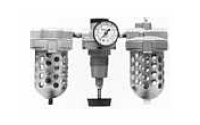CONFIGURATION INFO
J.HERBERT CORPORATION
CRANES & HOISTS

Hoists are available in a variety of configurations to suit the different material handling needs of end users. Standard options and customization alternatives can be provided depending on the application. In order to select the proper equipment, it is first necessary to determine your hoist requirements. General guidelines are provided below. For further assistance or to request a quote, please contact our Customer Service Department.
Requirements
Hoist Capacity
To determine hoist capacity, you should calculate the total load weight (maximum load to be lifted). This would include weight of material to be lifted, plus that of any additional attachments such as slings, spreader bars, or other devices used to help lift the material off the ground. If the total load weight falls between standard rated capacities, select the higher capacity rating.
Hoist Lift
To determine length of hoist lift required, it is necessary to measure from the bottom of the beam to the lowest point on the floor. From this amount then deduct the hoist headroom measurement as per the equipment specifications. In general, hoist headroom is considered to be the distance between the bottom of beam or trolley wheel flange and the saddle of the bottom hook when it is in the uppermost position. (See diagram):
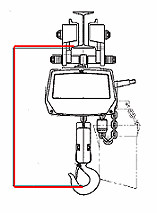
Hoist Lift Headroom Measurement
Hoist Suspension
In most applications, hoists are suspended overhead via a lug, hook or trolley. Lug suspensions are used when a hoist is permanently affixed to a location or to attach the hoist to a rigid mount trolley. Hook suspensions consist of a single point of suspension through the use of a top hook. Hook suspended hoists have the advantage of being easily moved from locations. Trolley suspensions incorporate a hoist attached to a push/manual, hand-geared, or motor driven trolley. (See diagram). A push trolley is generally used for relocating lighter loads and in instances where spotting is not crucial. a hand-geared trolley is used for loads that are slightly heavier and that require load spotting accuracy. Powered trolley are often incorporated in applications requiring the relocation of heavy loads, repetitive lifting and lowering, and for faster hoisting speeds.
Log Suspension
Hook Suspension
Push/Manual Trolley Suspension
Geared Trolley Suspension
Motorized Trolley Suspension
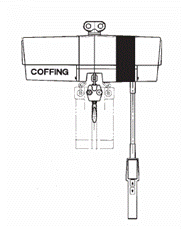
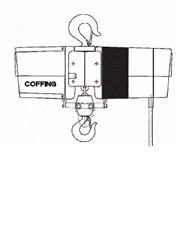

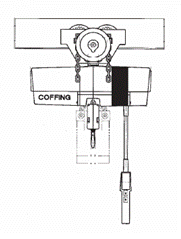
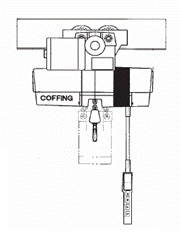
Hoist Types
Hoists are subdivided into different categories, based on how they are powered:
-
Hand Operated (Lever Hoists & Manual Hand Chain Hoists).
-
Electric (Chain and Wire Rope Hoists).
-
Air Powered (Chain and Wire Rope Models).
They are available in standard ratings, lift lengths, and speeds.
Variations are also possible depending on the make and model of the unit.
Lever Hoists
Lever Hoists are also known as "come-a-longs", "ratchet levers", or "pullers", and are used for applications requiring tightening, stretching, or positioning of the load. They are constructed out of aluminum, steel, or cast iron and incorporate a wire rope cable, webbing strap, or link/roller chain attached to a hook. The load is mobilized in small increments by ratcheting a lever. Brakes are either friction discs or ratchet and pawl. Overload protection options are available depending on the model and brand. Lever hoists are typically used in the construction, utility and farming industries. When selecting a ratchet lever hoist, it is important to know capacity desired, length of lift and type (cable, strap, chain).
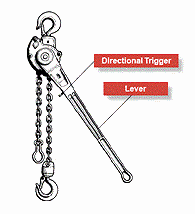
Manual Hand Chain Hoists

Hand chain hoists are frequently used for maintenance applications and for lifting machinery such as motors, pumps and generators. They are generally constructed out of aluminum alloy or steel, and incorporate a hand chain which requires pulling to move the load up or down.
Overload protection options are in the form of friction type, clutched hubs within the hand chain wheel design.
When selecting a hand chain hoist, it is important to know capacity, lift distance, length of hand chain (normally 2' less than lift, but can be modified), suspension, and special options such as chain containers, corrosion resistant chain and hooks, or spark resistant features.
Electric Hoists
Electric hoists are used for applications requiring repetitive and faster hoisting of the load. They incorporate a link chain or wire rope attached to a hook for lifting and lowering. Chain hoists offer true vertical lift where the load remains centered while lifting or lowering. Some wire rope models can be fabricated with true vertical lift features. Movement is accomplished through the use of electrical controls. These can be a pendant (pushbutton) station or radio transmitter. Overload protection options include devices such as internal friction clutches, electrical shut-off device, or low torque hoist motors. Duty cycle classification of electric hoists helps establish hoist run times within a particular period.
When selecting an electric hoist, it is important to know capacity desired, length of lift, lifting speed, type (chain or wire rope), power supply voltage, phase (single or three phase), control voltage (24v or 115v), pendant cord length (normally 4' less than lift, but can be modified), power cord length, duty cycle requirement, type of suspension, headroom limitations if any, and special options such as chain containers, corrosion resistant chain and hooks, or spark resistant features. If trolley is selected it is important to know type (manual, hand geared, or motorized), hand chain length for geared trolleys, trolley speed for motorized, beam type and size.

Air Hoists
Air hoists, like electric hoists, are used for applications requiring quick and frequent hoisting of the load. They are powered by an air compressor rather than an electrical current and use a lever pendant or pull rope to control the different hoisting functions.
Filter lubricator units are recommended to be installed on the air supply line. Regulators should also be installed if the air supply is over 90 psi. Because there is no electrical arcing, air hoists are ideal for hazardous environments or areas in which electricity is impractical. Air motors are self-cooling thus providing unlimited run time and number of starts.
When selecting an air hoist, it is important to know capacity desired, length of lift, lifting speed, type of control (pull or pendant), pull cord or pendant drop length, type of chain (link or roller), type of suspension (lug, hook, trolley), and special options such as chain containers and spark resistant features.
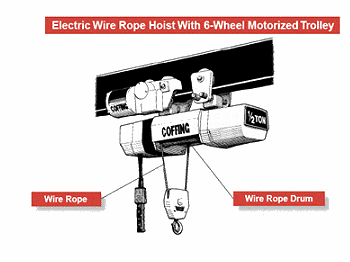
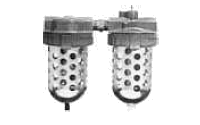
Filter - Lubricator Unit
